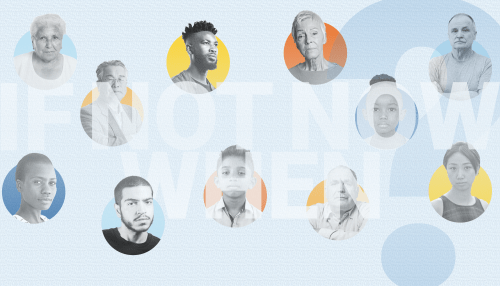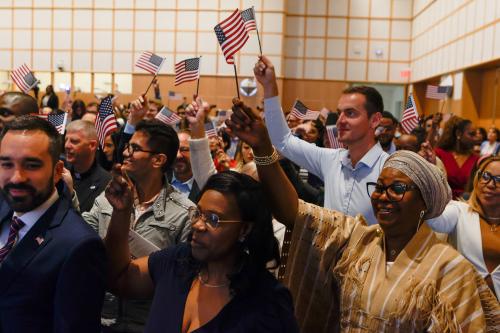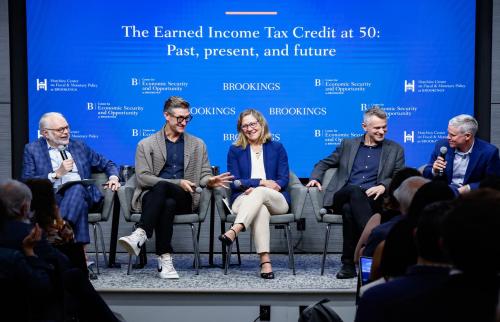This post summarizes the event How the American middle class is really doing, highlighting the work of the new Middle Class Monitor.
Last week, the Future of the Middle Class Initiative at Brookings launched the Brookings Middle Class Monitor and hosted a series of short accompanying panel discussions to highlight the issues affecting American middle-class families. The importance of this conversation cannot be overstated. In the past few years, middle-class families have faced increasingly challenging conditions. Back in 2018, (now President) Joe Biden joined us for the launch of the Initiative and said that “the middle class are in trouble. It’s not just their perception. They are in trouble.” And since then, the double crisis of the COVID-19 pandemic and the economic recession has made life that much more challenging for many middle-class Americans.
To tell this story—to understand what’s really going on in the middle class—we have launched the Middle Class Monitor which presents objective data across five key domains: money, time, relationships, health, and respect. Where possible, the data is broken down by income quintiles, race, gender, and education, to provide a comprehensive, highly detailed, and interactive database. The Monitor accompanies the previous work of Richard Reeves and Isabel Sawhill, A New Contract with the Middle Class (“the Contract”), in which they offer a suite of policies to improve the quality of life for the middle class and to increase the number of people rising to join its ranks. It also complements the American Middle Class Hopes and Anxieties Study (AMCHAS) which features stories of middle-class Americans from around the United States. These three pieces—real voices, real data, and real solutions—paint a complete picture of the American middle class, both over time and during the current pandemic, and show us a way forward.
The insights offered by our six panelists during last week’s event, moderated by Annie Lowrey, illuminate the data we have presented in the monitor and the work of the initiative. The discussion focused on three key trends: money, health, and family relationships.
Money matters
The first conversation focused on middle-class incomes and what Elisabeth Jacobs called the “running to stand still” phenomenon. A significant, and concerning, detail of this story is that essentially all the growth in the past few decades can be attributed to the rise in women’s labor force participation rates, as shown in the below graph from the Contract. For middle-class families, that means two earners must now be engaged in the labor market to maintain the same level of income once achieved by a single earner. They are working more hours for limited income growth and this has contributed to rising inequality, Elisabeth says, making it significantly harder for families to afford key aspects of the middle-class lifestyle (e.g., childcare, healthcare, education).
Jay Shambaugh echoed this concern by arguing that “this economy only seems to produce gains for the middle class when it is running pretty hot” – in other words, it is reliant on good macroeconomic policy to produce tangible benefits. Over the past several decades, there have been glimpses of improvement, but overall, middle-class workers have faced stagnating wages and rising costs of living—providing them no real traction to get ahead. These trends are clearly visible in the CPS and CBO income data in our Monitor. And it is especially true for typically marginalized groups who only started to see gains in their income in the last few years, but as Jay pointed out, that is essentially “making up for the fact that they were getting nothing or actually negative growth for a while.”
Healing America
We then heard from Dariush Mozaffarian and Dayna Bowen Matthew on how health issues are impacting the American middle class. Dariush highlighted the staggering figures on health, with more than half adults being overweight or obese, being diabetic or prediabetic, and having cardiovascular disease. Both the physical and mental health of the American middle class is getting progressively worse, as we highlighted in the Contract.
Dariush emphasized the vital role of good, healthy food as the fundamental solution to these health threats; arguing that hunger isn’t so much of a problem as nutrition security is. This applies across the board, as evidence points to a predominantly unhealthy population in America. Dariush also offered a reminder that health care, while vital, “does not make people healthier” – a point that we also emphasize in the Contract.
Dayna Bowen Matthew asked us to think about what these trends mean for structurally disadvantaged and vulnerable communities. So, while it might be true that many Americans are unhealthy, it has disproportionately adverse effects on Black and Brown communities. She pointed to the way structural inequalities—including, wage, wealth, and homeownership—contribute to unhealthy populations and make certain groups more vulnerable to shocks in the system—including, for example, a pandemic. Addressing the health issues in the American middle class requires a racially sensitive view as the disparities in social and economic institutions translate to disparities in health outcomes.
Family or community?
Lastly, David Williams and Brad Wilcox explored the changing dynamics of American families and how a stable environment promotes a strong middle class and aids social mobility. David Williams emphasized the overall importance of community formation, rather than specific family formation, as the most consequential factor in upward mobility. He discussed the benefits of area effects, and most specifically, the presence of two-parent households. However, he argued that marriage is not necessarily the driving, mechanical factor at play. Instead, marriage or two-parent households reflect other important factors, such as neighborhood cohesion or social capital. In this way, the nuclear family, while obviously important, is not the end-all-be-all for policy work. Community relationships matter just as much.
On the other hand, Bradford Wilcox specifically emphasized the importance of marriage and childrearing within marriage as a firm foundation for the middle class. He argued that there is no family model that delivers the same positive results for the middle class and to upward mobility as the married family model does. Further, if the idea is to promote stability within neighborhoods, he says, then marriage is the best way to get there. It provides a healthy and secure environment for children to grow up, to learn, and to one day join the middle class themselves. Either way, it is clear having two parents influences child outcomes, as demonstrated in the Middle Class Monitor.
Conclusion
The insightful comments offered by these panelists and the data we have presented on our monitor paint a clear picture of the middle class: they are struggling, and they need greater support. The pressure placed on middle class incomes, their deteriorating health, and the dramatically changing landscape of American families requires intentional policy formulation—especially as we begin to imagine a post-pandemic recovery.
Perhaps you disagree with this assessment; in which case, do dive into the data yourself, and let us know what you think.
The Brookings Institution is committed to quality, independence, and impact.
We are supported by a diverse array of funders. In line with our values and policies, each Brookings publication represents the sole views of its author(s).








Commentary
Monitoring the middle class: How the American middle class is really doing
February 11, 2021